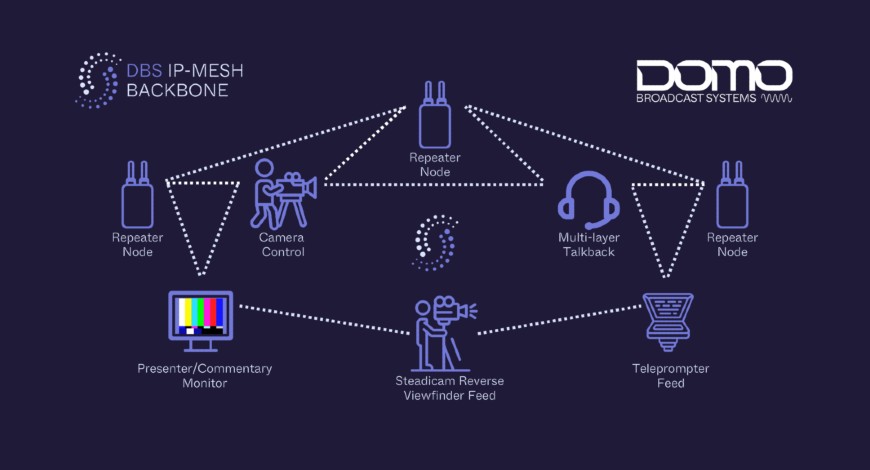Company News
DBS IP-Mesh Backbone lets you centralise control of your broadcast’s wireless assets

Domo Broadcast Systems (DBS) announces the release of DBS IP-Mesh Backbone, the sought-after solution that lets broadcasters centralise control of their wireless devices on a single RF channel.
While broadcasters’ wireless-camera video links can be handled by one of Domo Broadcast System’s conventional COFDM systems, everything else wireless handled by one centralised system via the DBS IP-Mesh Backbone. It helps broadcasters simplify their operations, reduce the number of RF channels used (and number of licences they need), and cut down on the amount of kit attached to cameras.
Domo Broadcast Systems’ fluid self-healing, self-forming, bi-directional mesh architecture allows transmitters to exchange and relay the highest quality video and data with ultra-low latency. The range can be extended by using repeater units or other mesh-enabled assets.
“With DBS IP-Mesh Backbone, the production team can monitor the performance and connectivity of their wireless assets from one central location ‒ from any node in the network via any common web browser,” says Stuart Brown, Commercial Director at Domo Broadcast Systems.
“And because less kit needs to be attached to cameras, it improves on rigging time, reduces the weight of camera units, and decreases the amount of kit that needs to be transported to broadcast event locations.”
How does the DBS IP-Mesh Backbone work?
The DBS IP-Mesh Backbone is founded on our renowned IP-Mesh system, which is a single-frequency, multi-node IP network. In a traditional wireless camera system, there is a transmitter and a receiver. In a Mesh network, every radio is both a transmitter and a receiver, so they’re called ‘nodes.’ Adding more nodes to the system adds flexibility by allowing for the creation of a scalable, self-forming, self-healing network of wireless devices.
Domo Broadcast Systems employs a time-division multiple access (TDMA) protocol. We use a token-managed channel access system whereby each node in the network is given a timeslot to transmit. The token is passed from node to node depending on network parameters and data traffic. So, if one node has more data to transmit, it will have a longer time slot. A particular node can be the end point for data, or it can be a repeater on the path for the ultimate destination.
IP-Mesh constantly readjusts itself as nodes move, working out which are in range and finding the best route to send data without compromising signal stability or video quality. If one node can no longer operate, the rest of the nodes can still communicate with each other, and act as a relay for the blocked node.
Launching at IBC 2022
The Domo Broadcast Systems team will be showcasing the DBS IP-Mesh Backbone at this year’s IBC exhibition at RAI Amsterdam, 9‒12 September. Those wanting to see a demo are invited to visit us in Hall 10 on our stand 10.D40. Globe Newswire




